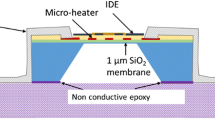Abstract
In this paper, technology for a gas sensor platform with borofloat as the substrate material is presented. Comprehensive characterization of the platform, its comparison with silicon and alumina, fabrication yield improvement and a study of reliability of the micro-heater platform have been carried out. Usually, the chips are suspended in air to reduce power consumption. However, the presented technology is a non-MEMS technique and doesn’t require any complex packaging. Borofloat has much lower thermal conductivity in comparison to silicon and alumina, thereby reducing the thermal losses, making it possible to operate the device with low power consumption. The process adapted for the fabrication of the gas sensor platform has lesser complexities and the process cost is reduced compared to conventional gas sensor fabrication, as it does not require thermal oxidation and bulk micromachining. Different substrates (silicon, alumina and glass) have been simulated using COMSOL to depict the benefit of lower thermal conductivity. Micro-heater has also been fabricted on all the three above mentioned substrates and the power consumption is compared. Various reliability analysis have been carried out on the glass based platform such as maximum temperature test, long term ON test and ON–OFF pulse test.















Similar content being viewed by others
References
Azad A, Akbar S, Mhaisalkar S, Birkefeld L, Goto K (1992) Solid-state gas sensors: a review. J Electrochem Soc 139:3690–3704
Chang W-Y, Hsihe Y-S (2016) Multilayer microheater based on glass substrate using MEMS technology. Microelectron Eng 149:25–30
Chen L, Yang Z, Clough W, Burns LD, Rydkin I (2016) Leak detection unit for refrigerant system, Google Patents 2016
Christofides C, Mandelis A (1990) Solid-state sensors for trace hydrogen gas detection. J Appl Phys 68:R1–R30
Das R, Goswami S, Borgohain R, Baruah S (2015) Study on sheet resistance variation in ZnO nanorod arrays upon exposure to LPG at room temperature, energy, power and environment: towards sustainable growth (ICEPE). In: 2015 International Conference on IEEE 2015, pp 1–6
Deshmukh S, Bandyopadhyay R, Bhattacharyya N, Pandey R, Jana A (2015) Application of electronic nose for industrial odors and gaseous emissions measurement and monitoring—an overview. Talanta 144:329–340
Hsing IM, Srinivasan R, Harold MP, Jensen KF, Schmidt MA (2000) Simulation of micromachined chemical reactors for heterogeneous partial oxidation reactions. Chem Eng Sci 55:3–13
Masudi J, Ramotsoela T, Hancke G (2007) A wireless communication system for environmental monitoring in smart cities. In: AFRICON, 2017 IEEE, pp 1541–1546
Prajesh R, Jain N, Khanna V, Gupta V, Agarwal A (2014) MEMS based integrated gas sensor for NO2 and NH3. J ISSS 3:1–6
Prajesh R, Jain N, Agarwal A (2015) Low cost packaging for gas sensors. Microsyst Technol 21:2265–2269
Prajesh R, Jain N, Agarwal A (2016) Low power highly sensitive platform for gas sensing application. Microsyst Technol 22:2185–2192
Prajesh R, Goyal V, Bhargava J, Sharma A, Agarwal A (2017) Pristine ZnO and SnO2 films for sensing of volatile organic compounds. Microsyst Technol 23:3027–3031
Pummakarnchana O, Tripathi N, Dutta J (2005) Air pollution monitoring and GIS modeling: a new use of nanotechnology based solid state gas sensors. Sci Technol Adv Mater 6:251–255
Suehle JS, Cavicchi RE, Gaitan M, Semancik S (1993) Tin oxide gas sensor fabricated using CMOS micro-hotplates and in situ processing. IEEE Electron Device Lett 14:118–120
Suriano D, Cassano G, Penza M (2014) A portable gas sensor system for air quality monitoring, sensors and microsystems. Springer, Berlin, pp 155–158
Acknowledgements
The authors would like to thank Prof. Santanu Chaudhury, Director, CSIR-CEERI (Grant no. MLP-104) for his motivational support, whole Smart Sensor Area staff for the technical support and Dr. S. Santosh for his technical help.
Author information
Authors and Affiliations
Corresponding author
Additional information
Publisher's Note
Springer Nature remains neutral with regard to jurisdictional claims in published maps and institutional affiliations.
Rights and permissions
About this article
Cite this article
Prajesh, R., Goyal, V., Saini, V. et al. Development and reliability analysis of micro gas sensor platform on glass substrate. Microsyst Technol 25, 3589–3597 (2019). https://doi.org/10.1007/s00542-019-04341-2
Received:
Accepted:
Published:
Issue Date:
DOI: https://doi.org/10.1007/s00542-019-04341-2




